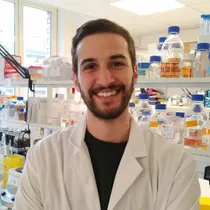Presentation

Regeneration is an injury induced process that involves multiple synergistic processes that act not only to limit the injury, but also generate new cells to replace the loss of tissue. In the heart, regenerative capacity varies widely among different species.
Heart Regeneration in Mammals
When mammals, such as humans experience a cardiac injury in a form of a myocardial infarction or heart attack, there is a very poor regenerative response. The injury causes a large amount of tissue death that is replaced by a permanent scar. This scar will prevent the heart from properly beating. Over time, the extra effort required for the heart to maintain normal heart beats is not sustainable and ultimately results in heart failure. Once patients reach this stage, there are very few treatment options apart from heart transplantation.
Figure 1. AFOG staining for heart tissue (orange), young scar (red) and old scar (blue) of a human heart after a heart attack with the zoom in panels depicting a region of uninjured tissue (A), a region that has an ongoing injury (B) and a region that has previously received an injury (C).
Heart Regeneration in Zebrafish
The zebrafish can robustly regenerate its heart following a heart injury. A scar is also formed following tissue death however this scar is transient and over time it will resolve. Simultaneously, the heart cells that survive the injury are able to reactivate proliferation and generate new heart tissue to replace all of the lost tissue.
Figure 2. Zebrafish hearts 7 days after injury showing overlap of proliferating cells (magenta) in heart cells (cyan).
Successfully Completing Regeneration in Zebrafish
The methods and mechanisms of how the heart can generate new tissue is intensively studied. What is not clear is what happens afterwards. This is particularly important since these newly generated cells must be able to mature and integrate with the rest of the heart. Failure to do so will result in arrythmias and reduced heart function.
In our lab, we use a combination of zebrafish genetics, advanced imaging, Next Generation Sequencing technologies to determine the factors and mechanisms that allow the zebrafish heart to successfully complete regeneration.
Figure 3. In order to determine the mechanisms of heart regeneration, we use a combination of zebrafish genetics, advanced imaging and next generation sequencing technologies.

















